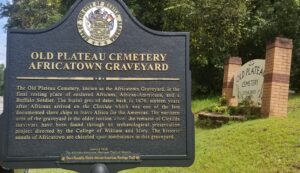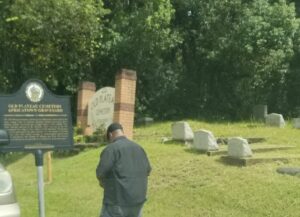MEET ARIANA
 We eventually stopped at the Old Plateau Cemetery Africatown Graveyard. There is a historic plaque at the entrance introducing you to its silent inhabitants of enslaved Africans, African Americans, and a Buffalo Soldier. The plaque also communicates that Old Plateau Cemetery Africatown Graveyard is their “final resting place.” The burial site dates back to 1876, sixteen years after Africans arrived on the Clotilda. I will never forget the somber expression on the faces of my parents. My mother’s eyes welled with tears, and my father was profoundly affected.
We eventually stopped at the Old Plateau Cemetery Africatown Graveyard. There is a historic plaque at the entrance introducing you to its silent inhabitants of enslaved Africans, African Americans, and a Buffalo Soldier. The plaque also communicates that Old Plateau Cemetery Africatown Graveyard is their “final resting place.” The burial site dates back to 1876, sixteen years after Africans arrived on the Clotilda. I will never forget the somber expression on the faces of my parents. My mother’s eyes welled with tears, and my father was profoundly affected.  I remember just watching him stand in utter silence. It wasn’t just his respect and reverence for the people buried there, but the realization of their resilience. No human should ever have to endure the horror of being kidnapped from their homes and families, brought to a foreign land, sold to slavers, forced to work as enslaved individuals from sun up to sun down, have their new families ripped apart from them, and whipped and beaten until they forgot their language, and in some way, even their identity. Africa Town is a grim reminder that the lives of Africans were considered worthless. And yet, through it all, we are still standing!
I remember just watching him stand in utter silence. It wasn’t just his respect and reverence for the people buried there, but the realization of their resilience. No human should ever have to endure the horror of being kidnapped from their homes and families, brought to a foreign land, sold to slavers, forced to work as enslaved individuals from sun up to sun down, have their new families ripped apart from them, and whipped and beaten until they forgot their language, and in some way, even their identity. Africa Town is a grim reminder that the lives of Africans were considered worthless. And yet, through it all, we are still standing!